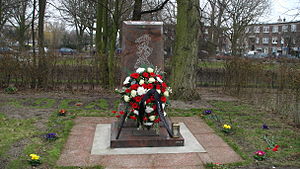
Back مذابح خوجالي Arabic Masacre de Khojaly AST Xocalı soyqırımı Azerbaijani خوجالی سویقیریمی AZB Хаджалінская разня Byelorussian Хаджалінская разьня BE-X-OLD Ходжалинско клане Bulgarian Massacre de Khojali Catalan کۆمەڵکوژیی خۆجالی CKB Hocalı soyqırımı CRH
| Khojaly massacre | |
|---|---|
| Part of the First Nagorno-Karabakh War | |
 Khojaly massacre memorial in The Hague, Netherlands | |
| Location | Khojaly, Nagorno-Karabakh |
| Target | Azerbaijani civilians |
| Deaths | 200+ (per Human Rights Watch)[1][2] 485 (per Azerbaijani parliament)[3] 613 (per Azerbaijani government)[4] |
| Perpetrators | Armenian forces 366th CIS regiment[5] |
The Khojaly massacre (Azerbaijani: Xocalı soyqırımı, Armenian: Խոջալուի արյունահեղություն, romanized: Khojalui aryunaheghut’yun) was the mass killing of Azerbaijani civilians by Armenian forces and the 366th CIS regiment in the town of Khojaly on 26 February 1992.[3][6][7][5][8] The event became the largest single massacre throughout the entire Nagorno-Karabakh conflict.[9]
Khojaly was an Azerbaijani-populated town of some 6,300 people in the Nagorno-Karabakh Autonomous Oblast of Azerbaijan SSR, also housing the region's only airport in 1992.[10] The town was subject to daily shelling and total blockade by Armenian forces during the First Nagorno-Karabakh War. Without supply of electricity, gas, or water, it was defended by the local forces consisting of about 160 lightly armed men. The Armenian forces, along with some troops of the 366th CIS regiment, launched an offensive in early 1992, forcing almost the entire Azerbaijani population of the enclave to flee, and committing "unconscionable acts of violence against civilians" as they fled.[1]
The massacre was one of the turning points during the First Nagorno-Karabakh War. The death toll given by the Azerbaijani authorities is 613 civilians, including 106 women and 63 children.[4] According to Human Rights Watch, at least 200 Azerbaijanis were killed during the massacre, though as many as 500–1,000 may have died.[2][11][12] This number includes combatants and those who died of cold.[13]
- ^ a b "Human Rights Watch World Report 1993 – The Former Soviet Union". Hrw.org. Archived from the original on 18 February 2015. Retrieved 28 April 2014.
- ^ a b Human Rights Watch/Helsinki (1994). Azerbaijan: Seven Years of Conflict in Nagorno-Karabakh. New York [u.a.]: Human Rights Watch. p. 5. ISBN 1-56432-142-8. Retrieved 12 March 2014.
- ^ a b de Waal, Thomas (2004). Black garden: Armenia and Azerbaijan through peace and war. ABC-CLIO. pp. 172–173. ISBN 0-8147-1945-7. Archived from the original on 3 June 2016.
- ^ a b "Letter dated 26 February 2015 from the Permanent Representative of the Republic of Azerbaijan to the United Nations Office at Geneva addressed to the President of the Human Rights Council". Archived from the original on 11 January 2016.
- ^ a b Denber, Rachel; Goldman, Robert K. (1992). Bloodshed in the Caucasus: Escalation of the Armed Conflict in Nagorno Karabakh. Human Rights Watch. p. 24. ISBN 978-1-56432-081-0.
- ^ "New York Times – massacre by Armenians Being Reported". Commonwealth of Independent States; Azerbaijan; Khojaly (Armenia); Armenia: Select.nytimes.com. 3 March 1992. Archived from the original on 11 March 2007. Retrieved 28 April 2014.
- ^ Smolowe, Jill (16 March 1992). "TIME Magazine – Tragedy Massacre in Khojaly". Time. Archived from the original on 28 February 2005. Retrieved 28 April 2014.
- ^ Small Nations and Great Powers: A Study of Ethnopolitical Conflict in the Caucasus By Svante E. Cornell
- ^ "Armenian and Azerbaijani leaders embrace denialism". eurasianet.org. Eurasianet. 22 November 2019. Retrieved 25 February 2021.
- ^ "ДОКЛАД ПРАВОЗАЩИТНОГО ЦЕНТРА «МЕМОРИАЛ» О МАССОВЫХ НАРУШЕНИЯХ ПРАВ ЧЕЛОВЕКА, СВЯЗАННЫХ С ЗАНЯТИЕМ НАСЕЛЕННОГО ПУНКТА ХОДЖАЛЫ В НОЧЬ С 25 НА 26 ФЕВРАЛЯ 1992 г. ВООРУЖЕННЫМИ ФОРМИРОВАНИЯМИ" (PDF). memohrc.org. Memorial. Retrieved 26 February 2021.
- ^ "Response to Armenian Government Letter on the town of Khojaly, Nagorno-Karabakh". hrw.org. Human Rights Watch. 23 March 1997. Retrieved 25 February 2021.
Yet we place direct responsibility for the civilian deaths with Karabakh Armenian forces.
- ^ Cite error: The named reference
memorialwas invoked but never defined (see the help page). - ^ The Black Garden, Thomas de Waal, ISBN 0-8147-1944-9, Page 171